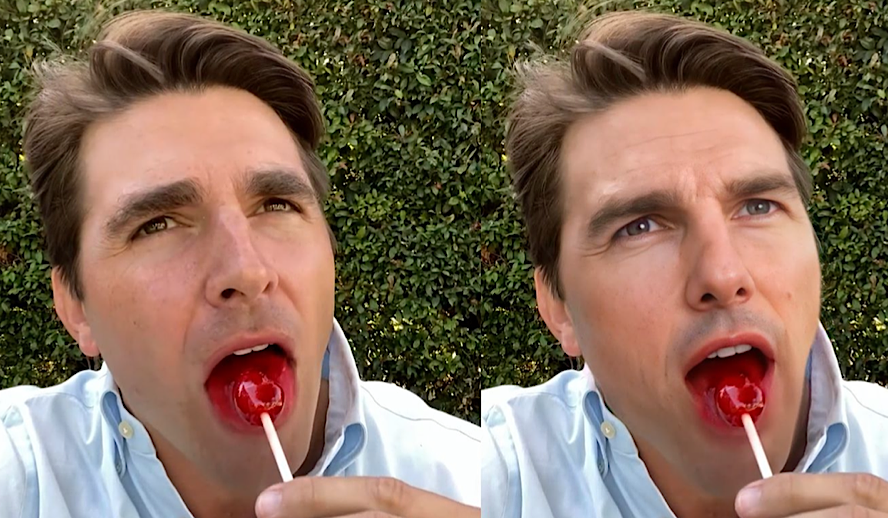
Photo: Deepfakes/Tiktok – @deeptomcruise
That smile, we all know it. Some of us love it. Some of us hate it. But we all know it: it’s Tom Cruise, or is it? When “Tom Cruise” recently popped up on the widely popular short-video app TikTok, literally popped into the frame while playing a hole of golf, everybody collectively thought: there’s no way! What’s Tom Cruise doing on TikTok? Because he sure looked like Tom Cruise; he sure sounded like Tom Cruise; he sure acted like Tom Cruise… except he wasn’t Tom Cruise. He was a deepfake version of Tom Cruise; he was Deepfake Tom Cruise, @deeptomcruise on TikTok.
Related article: Evolution of Technology in Cinema: Film to Digital, CGI, VFX, Motion Capture & Beyond
Related article: EVOLUTION: Every Tom Cruise Role From 1981 to 2021, All Performances Exceptionally Poignant
Of course, I’m exaggerating a little bit; it still takes a lot of time, skill, and knowledge to create something that could maybe pass as real; so maybe everybody can’t do it; and even then, you can usually tell if a piece of media is a deepfake or not; but ten years ago nobody would have thought this was technologically possible, even if it was always staring them in the face, as they flocked to big-screen to watch the latest Hollywood blockbuster. The question now is: where will we be in ten years from now?
Subscribe to Hollywood Insider’s YouTube Channel, by clicking here.
Deepfakes – Ban it! Regulate it! Embrace it!
For some that question is exciting and for others it’s scary. Still, maybe for others, it’s a bit of both? As we become more technologically savvy, and every day we are becoming more technologically savvy, there’s absolutely no doubt that deepfake technology will improve and improve exponentially, maybe to the point where anybody actually could create an entirely convincing deepfake, as easy as selecting an image of a person and dropping it into the video you want them to appear in and letting some app’s AI take care of the rest like it’s a Snapchat filter. If this reality were to become true (and it’s becoming truer every day), you could essentially remake any movie with the actors you want to see in it; you could be the star of your favorite movie; the possibilities are almost endless.
Everything that you ever imagined could be made real, represented as an image, whether that image was technically real or not, but what would it matter if you could see whatever you wanted (we’ll get into that later)? Technology ostensibly has the power to shape our world and make it fairer, more connected, and more immersive, at least according to tech-utopians, but the opposite sentiment could also be true: technology makes the world more biased, more fragmented, and more disassociated. Again, only time will tell how deepfakes fit into one of these narratives, but right now there are still various real political, economic, ethical, and even ontological implications for the continued use of deepfakes.
Related article: The Power of Positivity: Ikorodu Bois + Chris Hemsworth + Russo Brothers + Sam Hargrave
Limited Time Offer – FREE Subscription to Hollywood Insider
Deepfakes, to the extent that we understand them now, have been around for about five years, gaining equal-parts popularity and notoriety on websites like Reddit during various viral campaigns, preceding this current news cycle surrounding Deepfake Tom Cruise. Their reach extends far beyond the entertainment industry and actors though; they reach us too, forcing us to contend with questions like: do you own your own likeness? It’s a very simple question and the answer should be obvious, but like everything in this modern world, it’s anything but. In theory, yes, of course, you own your own likeness; that’s your face; but if you’ve ever signed a “Terms and Conditions” release for a social media company like Facebook in the past, you may now know that that isn’t the case: you signed away your rights to Facebook for the use of your pictures, your likeness, and you probably didn’t even notice at the time.
While a company probably won’t be making deepfakes out of your personal photos, there’s nothing from stopping somebody else from doing that, as we upload more and more content to these platforms. You may feel like you still own your pictures, but the internet rapidly subsumes things into itself and so do we as users of the internet, which make it manifest. We make deepfakes as much as we can be made into a deepfake. So, who will protect us from ourselves? There are calls for politicians to get involved in some way, citing the potential for numerous misappropriations of this technology from fraud to revenge-porn to copyright violation.
If anything is to be done right now on a larger scale (as certain states have already taken steps to curtail certain abuse), it will probably be in the area of the latter, which protects the interests and intellectual property of big business, always hard at work lobbying in Washington D.C., but copyright law, aggressive as it is, is also ambiguous; and currently, deepfakes appear to be fair use, protected as a form of parody under current copyright law. Even still, the more important question is: should anything be done?
Related article: Hollywood Insider’s CEO Pritan Ambroase: “The Importance of Venice Film Festival as the Protector of Cinema”
Related article: The Masters of Cinema Archives: Hollywood Insider Pays Tribute to ‘La Vie En Rose’, Exclusive Interview with Director Olivier Dahan
On Primal Desire: Searching for the Real
There are already numerous instances of the dead being brought to life in film and other mediums as “holograms” in large part due to these advancements in technology: in ‘Star Wars: Rogue One’, Peter Cushing is digitally resurrected from the grave to reprise his role as Grand Moff Tarkin (also making an appearance in the film, though still alive at the time, is a de-aged and deepfaked Carrie Fisher reprising her role as Princess Leia). The Cushing estate, no doubt, probably had to approve of his appearance in the film, but if even the dead can’t escape our digital designs for them, then where does that leave us? Deepfakes might appear to be an ethical problem, but they’re beyond our dialectical understanding of ethics (right v. wrong, good v. bad) in the sense that they are so intertwined in our experience of the real; and, in that way, it’s more of a metaphysical problem.
That’s why I posed the question above asking if anything should be done about deepfakes at all; I don’t know if anything can truly be done about the phenomenon in a meaningful way because our experience of the real cannot be dialectically reconciled as right or wrong. What’s more or less real? Who am I to say? And what’s more real and what’s less real when considering an image? All representative art is subject to manipulation, but we still want there to be an absolute distinction between right and wrong and real and fake; and, ultimately, that’s a desire that film is always trying to reconcile with because we can’t reconcile it in our own lives.
Related article: Come Behind The Scenes TOP GUN: MAVERICK Tom Cruise, Miles Teller, Val Kilmer, Jennifer Connelly
Related article: EVOLUTION: Every Henry Cavill Role From 2001 to 2021, All Performances Exceptionally Poignant
French film critic Andre Bazin talks about “the myth of total cinema” in his seminal text What is Cinema?, in which he critiques the idea that the goal of film is the complete reproduction of reality, positing instead that it’s in the areas that film lacks a sense reality that give it beauty, but Cinema, nonetheless, continues to move toward this limit of the real, as observed by the emergence of 3D and 4D technology in addition to the advancements in VFX. We want film to appear real precisely because we know it’s not, allowing us to simulate this distinction we desire so much, but as our films become more realistic, our real lives become more like the movies we watch: more and more deepfaked.
And so it goes, so it goes. It’s a classic story: did the chicken come before the egg? Or was it the other way around? Did we come first or did movies? Total Cinema isn’t a myth anymore; we are that total Cinema, an ouroboros going round and round; but at least we’re having some fun, for now. The scary part comes later. Anyways, I remember in school we were always told never to end a paper with a quote, but I’ve always been kind of a rule-breaker; so I’ll hand it over to @deeptomcruise and let him have the last word (that seems to be where things are going anyways). @deeptomcruise: “It’s the real thing. It’s all the real thing.”
You can see the real Tom Cruise this summer in ‘Top Gun: Maverick’, releasing July 4th weekend.
An excerpt from the love letter: Hollywood Insider’s CEO/editor-in-chief Pritan Ambroase affirms, “Hollywood Insider fully supports the much-needed Black Lives Matter movement. We are actively, physically and digitally a part of this global movement. We will continue reporting on this major issue of police brutality and legal murders of Black people to hold the system accountable. We will continue reporting on this major issue with kindness and respect to all Black people, as each and every one of them are seen and heard. Just a reminder, that the Black Lives Matter movement is about more than just police brutality and extends into banking, housing, education, medical, infrastructure, etc. We have the space and time for all your stories. We believe in peaceful/non-violent protests and I would like to request the rest of media to focus on 95% of the protests that are peaceful and working effectively with positive changes happening daily. Media has a responsibility to better the world and Hollywood Insider will continue to do so.”
Ways to support Black Lives Matter Movement to end systemic racism
More Interesting Stories From Hollywood Insider
– Want GUARANTEED SUCCESS? Remove these ten words from your vocabulary| Transform your life INSTANTLY
– Compilation: All James Bond 007 Opening Sequences From 1962 Sean Connery to Daniel Craig
– Do you know the hidden messages in ‘Call Me By Your Name’? Find out behind the scenes facts in the full commentary and In-depth analysis of the cinematic masterpiece
– A Tribute To The Academy Awards: All Best Actor/Actress Speeches From The Beginning Of Oscars 1929-2019 | From Rami Malek, Leonardo DiCaprio To Denzel Washington, Halle Berry & Beyond | From Olivia Colman, Meryl Streep To Bette Davis & Beyond
– In the 32nd Year Of His Career, Keanu Reeves’ Face Continues To Reign After Launching Movies Earning Over $4.3 Billion In Total – “John Wick”, “Toy Story 4”, “Matrix”, And Many More
deepfakes, deepfakes, deepfakes, deepfakes, deepfakes, deepfakes, deepfakes, deepfakes, deepfakes, deepfakes, deepfakes, deepfakes, deepfakes, deepfakes, deepfakes, deepfakes, deepfakes, deepfakes, deepfakes, deepfakes, deepfakes









